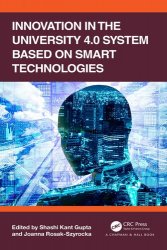 Название: Innovation in the University 4.0 System based on Smart Technologies
Название: Innovation in the University 4.0 System based on Smart TechnologiesАвтор: Shashi Kant Gupta, Joanna Rosak-Szyrocka
Издательство: CRC Press
Год: 2024
Страниц: 241
Язык: английский
Формат: pdf (true)
Размер: 36.2 MB
This text presents a comprehensive analysis of mathematical formulations for proving the effectiveness of Artificial Intelligence in education and investigates the possibilities for integrating advanced Artificial Intelligence algorithms. The book:
• presents an empirical analysis of the impact of information technology in the education system
• discusses student performance in university 4.0 using novel Artificial Intelligence algorithm with whale optimization
• elaborates the management of higher education based on information technology in the university 4.0 era
• explains the implementation of university 4.0 based on Artificial Intelligence
• focuses on the transformation of education system using Artificial Intelligence.
Artificial Intelligence (AI) in education signifies a paradigm shift in teaching and learning. A major driving force behind AI is the concept of neural networks and Deep Learning. These powerful tools enable AI applications to deliver personalized, dynamic, and engaging learning experiences. To understand the role of these technologies in education, we must first comprehend the basics. Neural networks are AI systems modeled after the human brain, consisting of interconnected layers of nodes, or “neurons,” that process information. These layers constitute an input layer, one or more hidden layers, and an output layer. Each node processes the input it receives and passes on the result, simulating the process of human brain cells transmitting signals. Deep Learning, a subset of Machine Learning, involves using neural networks with multiple hidden layers. These layers enable the system to learn from data inputs and adjust its internal parameters to make accurate predictions or decisions. The “depth” in Deep Learning denotes these multiple layers, and it is this depth that facilitates more complex, nuanced learning and prediction capabilities. In the context of education, these technologies present immense possibilities. Personalized learning is one of the most compelling applications of neural networks and Deep Learning in education. These technologies can analyze vast data on student performance and learning styles. By processing this data, AI systems can adapt teaching materials and instructional strategies to cater to the unique needs of each learner, thereby enhancing the efficacy of teaching and learning. AI can identify patterns in a student’s learning behavior, detect areas of weakness or strength, and then modify the content delivery accordingly. Neural networks (NNs) and Deep Learning represent two of the most fascinating and significant advancements in Artificial Intelligence. Through these technologies, machines can learn, adapt, and even make decisions in a manner previously thought to be the exclusive domain of the human brain.
The text is primarily written for graduate students, postgraduate students, and academic researchers working in the fields of Computer Science and engineering, information technology and Machine Learning.
Скачать Innovation in the University 4.0 System based on Smart Technologies